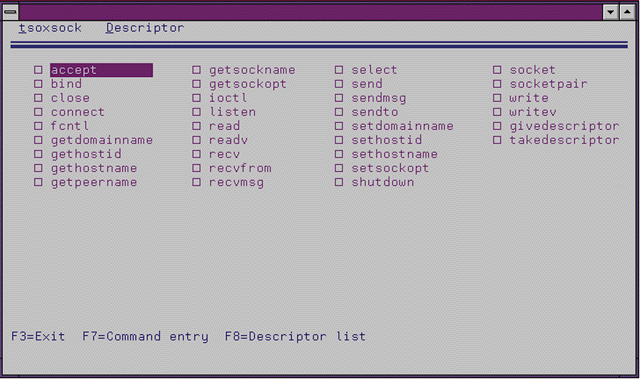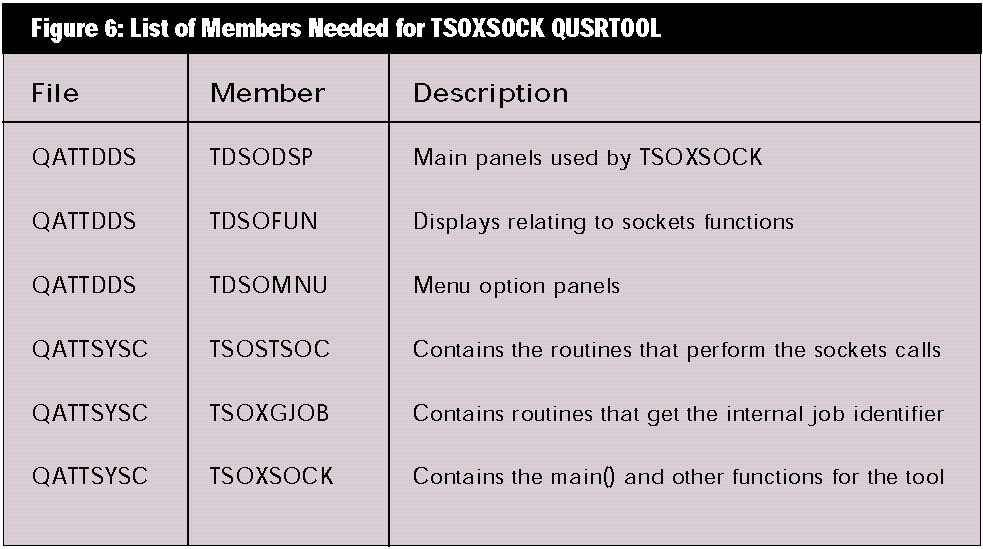I've covered some of the basics of writing a sockets program in previous articles (see "Introduction to Sockets," MC, September 1995 and "Plug In to Sockets," MC, January 1996). Sockets is a communications API commonly used over the TCP/IP protocol. Maybe you've read those articles and you're still having a hard time writing your own sockets programs.
If that's the case, you might want to turn to QUSRTOOL. The V3R1 version of QUSRTOOL contains a new set of Cand DDS source members that are example sockets programs. The program TSOXSOCK allows you to interactively issue sockets function calls. (You can see what TSOXSOCK looks like in 5.) What better way to learn how to use the sockets functions?
If that's the case, you might want to turn to QUSRTOOL. The V3R1 version of QUSRTOOL contains a new set of Cand DDS source members that are example sockets programs. The program TSOXSOCK allows you to interactively issue sockets function calls. (You can see what TSOXSOCK looks like in Figure 5.) What better way to learn how to use the sockets functions?
6 contains a list of the members you need to compile in order to get this tool working. One note of caution, though: Remember that the tools in QUSRTOOL are not supported. For example, one problem I had was that the DDS source members had a type of LF. However, if you're trying to learn this important API, TSOXSOCK may be just the tool you need.
Figure 6 contains a list of the members you need to compile in order to get this tool working. One note of caution, though: Remember that the tools in QUSRTOOL are not supported. For example, one problem I had was that the DDS source members had a type of LF. However, if you're trying to learn this important API, TSOXSOCK may be just the tool you need.
- Jim Hoopes
TechTalk: If you need help writing a sockets program, turn to QUSRTOOL.
Figure 5: QUSRTOOL Sockets Tool Screen

TechTalk: If you need help writing a sockets program, turn to QUSRTOOL.
Figure 6: List of Members Needed for TSOXSOCK QUSRTOOL












 Business users want new applications now. Market and regulatory pressures require faster application updates and delivery into production. Your IBM i developers may be approaching retirement, and you see no sure way to fill their positions with experienced developers. In addition, you may be caught between maintaining your existing applications and the uncertainty of moving to something new.
Business users want new applications now. Market and regulatory pressures require faster application updates and delivery into production. Your IBM i developers may be approaching retirement, and you see no sure way to fill their positions with experienced developers. In addition, you may be caught between maintaining your existing applications and the uncertainty of moving to something new. IT managers hoping to find new IBM i talent are discovering that the pool of experienced RPG programmers and operators or administrators with intimate knowledge of the operating system and the applications that run on it is small. This begs the question: How will you manage the platform that supports such a big part of your business? This guide offers strategies and software suggestions to help you plan IT staffing and resources and smooth the transition after your AS/400 talent retires. Read on to learn:
IT managers hoping to find new IBM i talent are discovering that the pool of experienced RPG programmers and operators or administrators with intimate knowledge of the operating system and the applications that run on it is small. This begs the question: How will you manage the platform that supports such a big part of your business? This guide offers strategies and software suggestions to help you plan IT staffing and resources and smooth the transition after your AS/400 talent retires. Read on to learn:
LATEST COMMENTS
MC Press Online